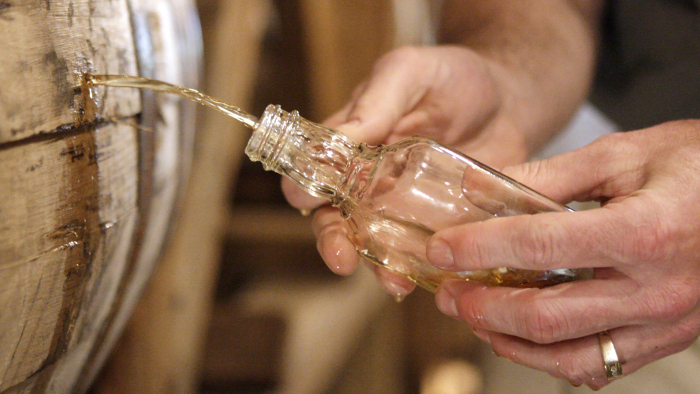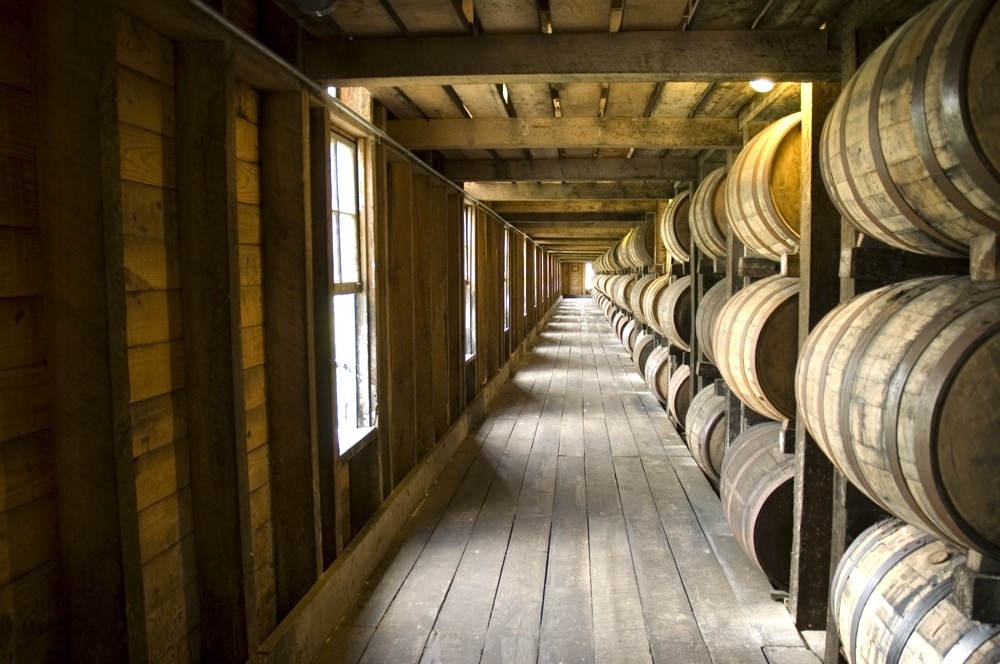
You have every right to be upset. Crying. Sad.
Maker's Mark bourbon — that kind of friend who keeps you warm when nights are cold and makes things fun when dates are boring — is going to change. The company announced over the weekend that it's lowering the alcohol content by 3% to meet increased consumer demand.
To get into details: They're taking it from 45% alcohol by volume (ABV) to 42%, or from 90 proof to 84 proof, effective immediately. And the company says it's doing so by cutting the bourbon with more water than previously.
"Consumers have the right to be concerned and disappointed. And I'm glad this is making headlines, but there's a storyline underneath all of this that I really believe is based on service to their customers, not making more money," says Jim Meehan, a James Beard Award–winning bartender based in NYC. "You might think that Maker's has to be 45, but if it's not terrible at 42 and they can fulfill demand, that's something to consider." (He also added, as a side note: "If we want to get all nerdy and pull at our mustaches, let's talk about about microdistilleries putting wood chips in their barrels, or companies that say their Bourbon's from Vermont when it's from Canada." Meaning there are worse sins in the whiskey industry, certainly.)
So this is sad, but it may not be THE WORST THING EVER. Moreover, everyone needs to just calm down and understand the facts before being Mean About It on the Internet.
1. A lot of whiskey brands drop their proof and say nothing about it.
Demand for whiskey is increasing at an astonishing rate. both domestically and internationally. Most companies are trying to figure out how to stretch their product, and some aren't very transparent about how they've done so.
For example, Wild Turkey Rye used to be 101 proof; now that proof is very hard to find, and the company is making a more widely available 81-proof rye. That's a hell of a change — probably necessary due to growing demand — and the company wasn't so upfront about it.
In the case of Maker's Mark, the change is less drastic, and they're talking to press all over the place: The current chief operating officer, Rob Samuels, and his 71-year-old father, former company president Bill Samuels, Jr. (whose dad started the company), issued long, thoughtful statements about what was going on and why.
2. They could have made it even less boozy, but they didn't.
By law, "straight bourbon" can't be diluted below 80 proof or 40% ABV. (In the U.S., proof is twice the ABV. So 80 proof is the same as 40% ABV, 100 proof is 50% ABV, etc.) Granted, our other favorite bourbons with the same price point range from 43 to 51 proof, but we have to wait and see how the new Maker's tastes at 42%.

3. They could have changed the aging process, but they didn't.
Another way to stretch the supply of bourbon is to age it for less time. The aging process for Maker's is a minimum of five years and nine months to seven years max. "Over the years, our one variable that helps us avoid market shortages has been the age of the whiskey in the Maker's bottle," Bill Samuels, Jr. said in his statement.
But they couldn't push it any more — the product starts to taste too "grainy" when aged for less than six years, he told Quartz.
4. They could have made it "rare," and they didn't.
Supply is a tricky thing for high-quality alcohol brands that are extremely popular because they have a limited amount of product. Brands like Pappy Van Winkle and Sazerac (which are owned by the same company) are constantly undersupplied, and that turns into a marketing ploy.
Put it this way: Yes, everyone is obsessed with Pappy Van Winkle, but it is impossible to find, which is a pain in the neck for restaurant, bar, and liquor store owners all over the world who want to get their hands on some.
Maker's has decided not to put their customers — mainly those restaurants and bars — in this position. "The biggest ones are the bars and restaurants that have Maker's Mark cocktails on their menus. We're taking care of customers who have been with us for a long time," the Samuels told Quartz.

5. They could have made it more expensive, and they didn't.
Raising price is another way to cut down demand. The Samuels say they didn't raise the price because they want it to be affordable. Who knows how true that is. There are some theories that this is all about money, getting into more grocery stores, etc. But at the end of the day — assuming this new Maker's doesn't taste like dirt — wouldn't you rather that Maker's didn't just suddenly jump out of a reasonable price range? Like a friend who gets famous and rich and is suddenly too cool?
6. Maker's is still a Kentucky Straight Bourbon Whiskey.
A bottle of booze labeled "Kentucky Straight Bourbon Whiskey" is always going to be a good bottle of booze. Because it's like "Champagne" or "Cognac" — there are a hell of a lot of rules to follow and these families have been doing this for a long damn time.
A few examples of the rules:
• The primary ingredient in bourbon's mash ("mash" are the grains that are steeped in hot water and rested at various temperatures to ferment and make booze) is corn — at least 51% by law and up to 79%.
• Bourbon is distilled below 160 proof, aged at no more than 125 proof, and can't be diluted below 80 proof.
• Bourbon is aged in new, charred, white-oak barrels.
• Any bourbon marketed as "straight" must be aged at least two years.
• If it is aged less than four years and marked as "straight," it has to say its age on the label, and the age listed there will refer to the youngest whiskey in the bottle. (Because sometimes one bottle will contain a mix of whiskeys aged different amounts of time.)
With the exception of Jim Beam White, which is kind of gross unless you're at a frat party and have absolutely no choice, basically all Kentucky straight bourbon whiskeys are awesome.

7. It could be (and, heck, it might get) worse.
Jim Beam acquired Maker's Mark in 2005. (Well actually, its parent company bought Maker's, then Beam spun off into a separate company of all spirits called Beam Inc.) The Samuels father-and-son duo said that this decision was "made locally."
OK, but what if Jim Beam decides to make Maker's Mark at the Beam distillery to save costs? That's a much bigger problem. All of the other things that contribute to Maker's Mark — the shape of the stills, the barrels, the ingredients in the mash — those things would be a much bigger deal. Maybe not as sexy of a news story, but, in reality, a much bigger deal.
Basically, let's just wait and see how it tastes.
Because unless you drink your Maker's Mark neat, this is basically like having an ice cube in it for 10 extra seconds before you start drinking. Not something you'd freak out about.
